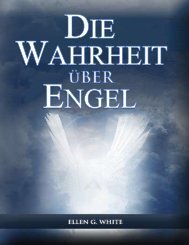Finishing the Race
Of all the games instituted among the Greeks and the Romans, the races were the most ancient and the most highly esteemed … The contests were governed by strict regulations, from which there was no appeal. Those who desired their names entered as competitors for the prize had first to undergo a severe preparatory training. Harmful indulgence of appetite, or any other gratification that would lower mental or physical vigour, was strictly forbidden. For one to have any hope of success in these trials of strength and speed, the muscles must be strong and supple, and the nerves well under control. Every movement must be certain, every step swift and unswerving; the physical powers must reach the highest mark.
Of all the games instituted among the Greeks and the Romans, the races were the most ancient and the most highly esteemed … The contests were governed by strict regulations, from which there was no appeal. Those who desired their names entered as competitors for the prize had first to undergo a severe preparatory training. Harmful indulgence of appetite, or any other gratification that would lower mental or physical vigour, was strictly forbidden. For one to have any hope of success in these trials of strength and speed, the muscles must be strong and supple, and the nerves well under control. Every movement must be certain, every step swift and unswerving; the physical powers must reach the highest mark.
You also want an ePaper? Increase the reach of your titles
YUMPU automatically turns print PDFs into web optimized ePapers that Google loves.
positions which had been established by unmistakable fulfillments of prophecy. But God<br />
had led His people in <strong>the</strong> great advent movement; His power and glory had attended <strong>the</strong><br />
work, and He would not permit it to end in darkness and disappointment, to be reproached<br />
as a false and fanatical excitement. He would not leave His word involved in doubt and<br />
uncertainty.<br />
Though many abandoned <strong>the</strong>ir former reckoning of <strong>the</strong> prophetic periods and denied <strong>the</strong><br />
correctness of <strong>the</strong> movement based <strong>the</strong>reon, o<strong>the</strong>rs were unwilling to renounce points of<br />
faith and experience that were sustained by <strong>the</strong> Scriptures and by <strong>the</strong> witness of <strong>the</strong> Spirit of<br />
God. They believed that <strong>the</strong>y had adopted sound principles of interpretation in <strong>the</strong>ir study of<br />
<strong>the</strong> prophecies, and that it was <strong>the</strong>ir duty to hold fast <strong>the</strong> truths already gained, and to<br />
continue <strong>the</strong> same course of Biblical research. With earnest prayer <strong>the</strong>y reviewed <strong>the</strong>ir<br />
position and studied <strong>the</strong> Scriptures to discover <strong>the</strong>ir mistake. As <strong>the</strong>y could see no error in<br />
<strong>the</strong>ir reckoning of <strong>the</strong> prophetic periods, <strong>the</strong>y were led to examine more closely <strong>the</strong> subject<br />
of <strong>the</strong> sanctuary.<br />
In <strong>the</strong>ir investigation <strong>the</strong>y learned that <strong>the</strong>re is no Scripture evidence sustaining <strong>the</strong><br />
popular view that <strong>the</strong> earth is <strong>the</strong> sanctuary; but <strong>the</strong>y found in <strong>the</strong> Bible a full explanation of<br />
<strong>the</strong> subject of <strong>the</strong> sanctuary, its nature, location, and services; <strong>the</strong> testimony of <strong>the</strong> sacred<br />
writers being so clear and ample as to place <strong>the</strong> matter beyond all question. The apostle<br />
Paul, in <strong>the</strong> Epistle to <strong>the</strong> Hebrews, says: "Then verily <strong>the</strong> first covenant had also ordinances<br />
of divine service, and a worldly sanctuary. For <strong>the</strong>re was a tabernacle made; <strong>the</strong> first,<br />
wherein was <strong>the</strong> candlestick, and <strong>the</strong> table, and <strong>the</strong> shewbread; which is called <strong>the</strong><br />
sanctuary. And after <strong>the</strong> second veil, <strong>the</strong> tabernacle which is called <strong>the</strong> holiest of all; which<br />
had <strong>the</strong> golden censer, and <strong>the</strong> ark of <strong>the</strong> covenant overlaid round about with gold, wherein<br />
was <strong>the</strong> golden pot that had manna, and Aaron's rod that budded, and <strong>the</strong> tables of <strong>the</strong><br />
covenant; and over it <strong>the</strong> cherubims of glory shadowing <strong>the</strong> mercy seat." Hebrews 9:1-5.<br />
The sanctuary to which Paul here refers was <strong>the</strong> tabernacle built by Moses at <strong>the</strong><br />
command of God as <strong>the</strong> earthly dwelling place of <strong>the</strong> Most High. "Let <strong>the</strong>m make Me a<br />
sanctuary; that I may dwell among <strong>the</strong>m" (Exodus 25:8), was <strong>the</strong> direction given to Moses<br />
while in <strong>the</strong> mount with God. The Israelites were journeying through <strong>the</strong> wilderness, and<br />
<strong>the</strong> tabernacle was so constructed that it could be removed from place to place; yet it was a<br />
structure of great magnificence. Its walls consisted of upright boards heavily plated with<br />
gold and set in sockets of silver, while <strong>the</strong> roof was formed of a series of curtains, or<br />
coverings, <strong>the</strong> outer of skins, <strong>the</strong> innermost of fine linen beautifully wrought with figures of<br />
cherubim. Besides <strong>the</strong> outer court, which contained <strong>the</strong> altar of burnt offering, <strong>the</strong> tabernacle<br />
itself consisted of two apartments called <strong>the</strong> holy and <strong>the</strong> most holy place, separated by a<br />
rich and beautiful curtain, or veil; a similar veil closed <strong>the</strong> entrance to <strong>the</strong> first apartment.<br />
In <strong>the</strong> holy place was <strong>the</strong> candlestick, on <strong>the</strong> south, with its seven lamps giving light to<br />
<strong>the</strong> sanctuary both by day and by night; on <strong>the</strong> north stood <strong>the</strong> table of shewbread; and<br />
before <strong>the</strong> veil separating <strong>the</strong> holy from <strong>the</strong> most holy was <strong>the</strong> golden altar of incense, from<br />
258
















